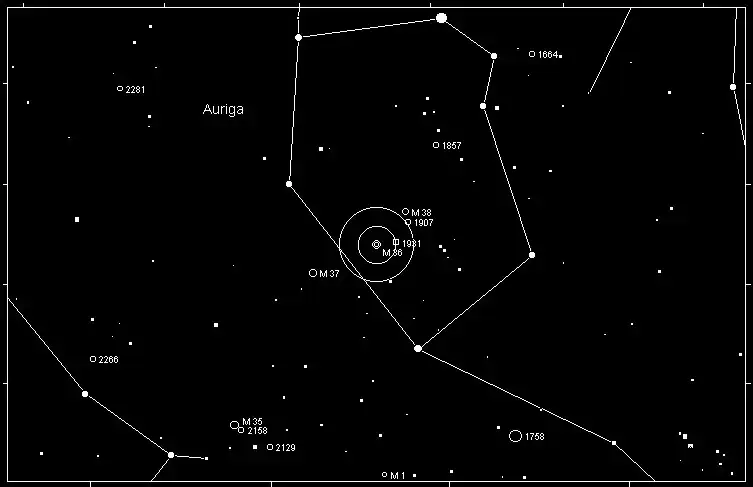Messier 36 (M36), also known as NGC 1960, is an open star cluster located in the constellation of Auriga. This cluster is one of the standout features of the northern sky and is known for its sparkling collection of young, hot stars. M36 is part of a trio of open clusters in Auriga, along with Messier 37 (M37) and Messier 38 (M38). Among the three, M36 is the smallest and least dense, but it remains a stunning sight through a telescope.
The stars in M36 are estimated to be around 25 million years old, making this cluster relatively young in cosmic terms. It contains around 60 stars, including several B-type main-sequence stars that give it its characteristic blue glow. The cluster spans about 14 light-years in diameter and lies approximately 4,100 light-years from Earth.
Magnitude
M36 has an apparent magnitude of 6.3, which means it is not visible to the naked eye under normal conditions but can be easily spotted with binoculars or a small telescope. The stars in M36 are relatively faint individually, but the cluster's combined light makes it a notable object in the night sky.

Prominence in the Sky and Best Viewing Season
M36 is best observed during the winter months in the Northern Hemisphere, particularly from December to February. During this time, the constellation Auriga, in which M36 resides, is prominently placed high in the sky during the evening hours, making it an ideal time for observation. Auriga can be seen almost directly overhead in mid-northern latitudes, providing optimal viewing conditions.
Constellation: Auriga
M36 is located in the constellation of Auriga, the Charioteer. Auriga is one of the 88 modern constellations and is easily recognizable due to its bright star, Capella, which is one of the brightest stars in the night sky. Auriga is often depicted as a charioteer holding a goat, and its distinctive shape makes it relatively easy to locate.
How to Find M36
To locate M36, begin by finding the constellation Auriga, which is easily identified by the bright star Capella. Once you have located Capella, look slightly to the south and west, where you will find a triangle of stars that represent the main stars of Auriga. M36 is located about midway between the stars M38 and M37, the other two open clusters in Auriga. It can be found approximately 1,600 light-years away from the star Menkalinan (Beta Aurigae), which forms part of the main pattern of Auriga.
Using a telescope with a low to medium magnification (around 50x), you should be able to see M36 as a small, compact cluster of stars. Higher magnifications can resolve some of the individual stars, particularly the brighter B-type stars, which stand out with a bluish hue.

History
Messier 36 was discovered by the Italian astronomer Giovanni Battista Hodierna before 1654. Hodierna was a contemporary of Galileo and cataloged many celestial objects that were later rediscovered by other astronomers. Charles Messier included M36 in his famous catalog of nebulous objects in 1764, which he compiled to help comet hunters avoid confusing these deep-sky objects with comets.
M36 is an important cluster for studying the evolution of stars in open clusters. Because it is relatively young and still contains many massive stars, astronomers have used M36 to study the dynamics of stellar formation and the dispersal of star clusters over time.
Conclusion
Messier 36 is a beautiful example of an open star cluster, offering amateur astronomers a glimpse into the dynamic and youthful stages of stellar evolution. Located in the constellation of Auriga, it is best observed in the winter months, where it can be found nestled among the stars with the help of a telescope. Its historical significance and striking appearance make M36 a must-see object for stargazers and astronomers alike.
